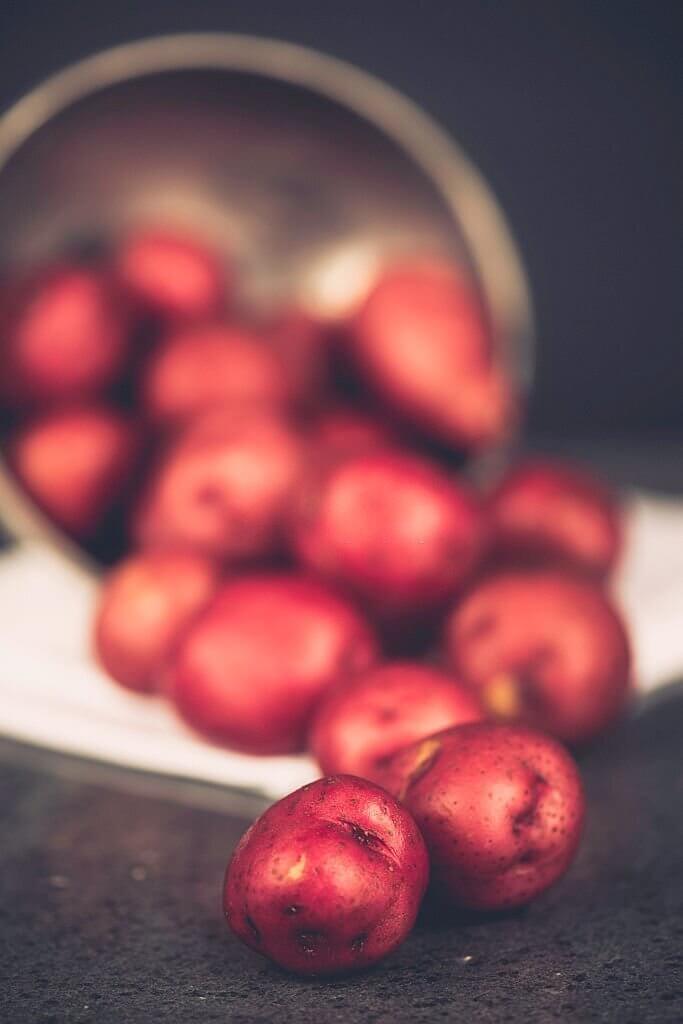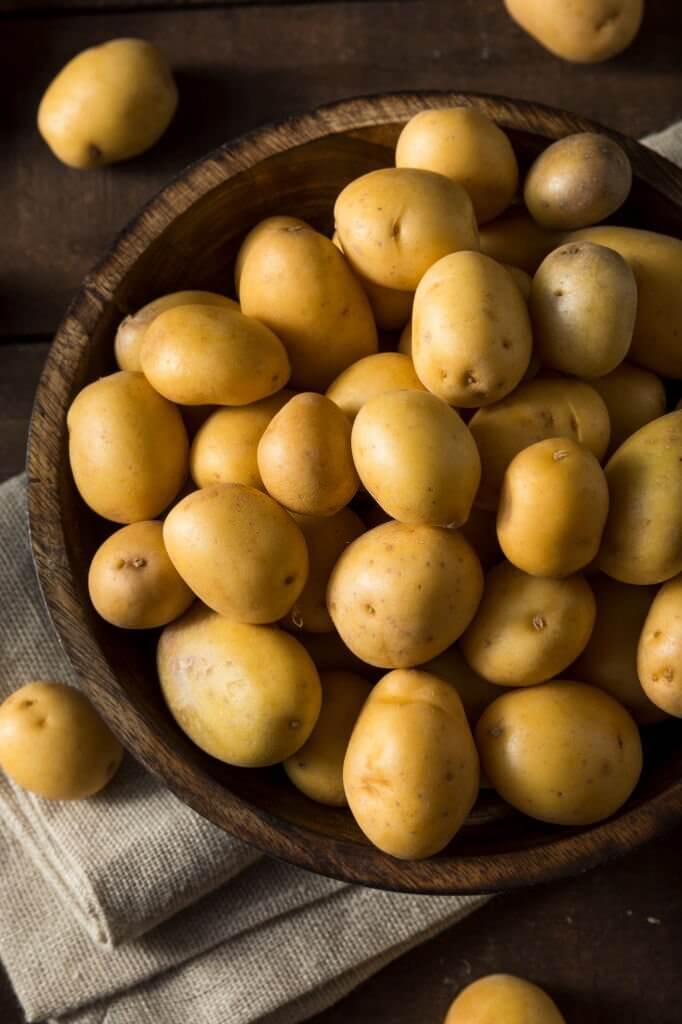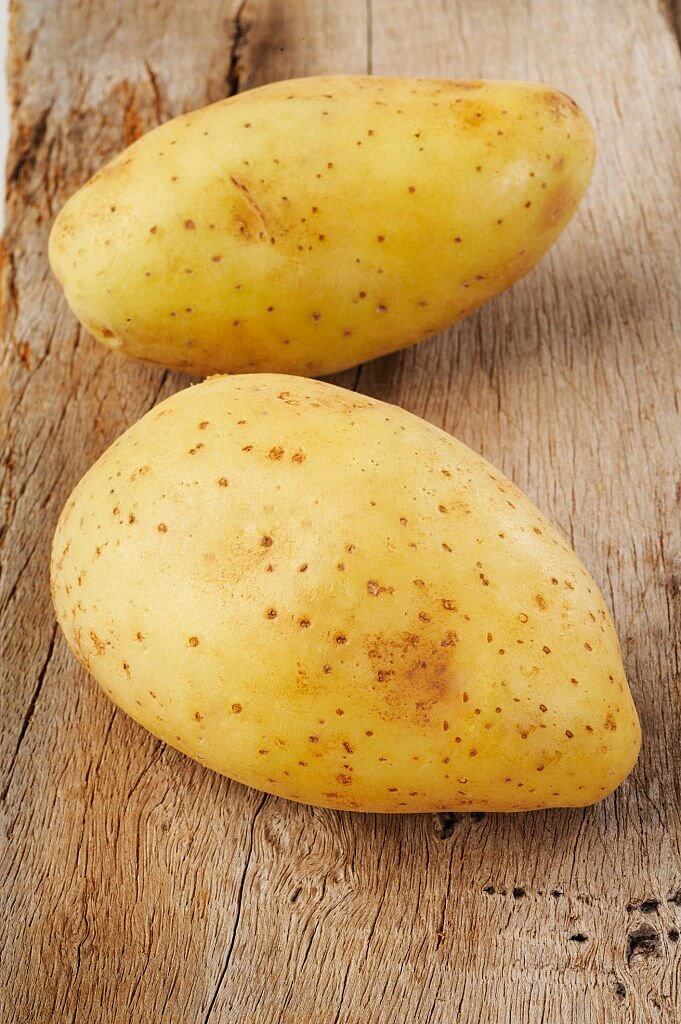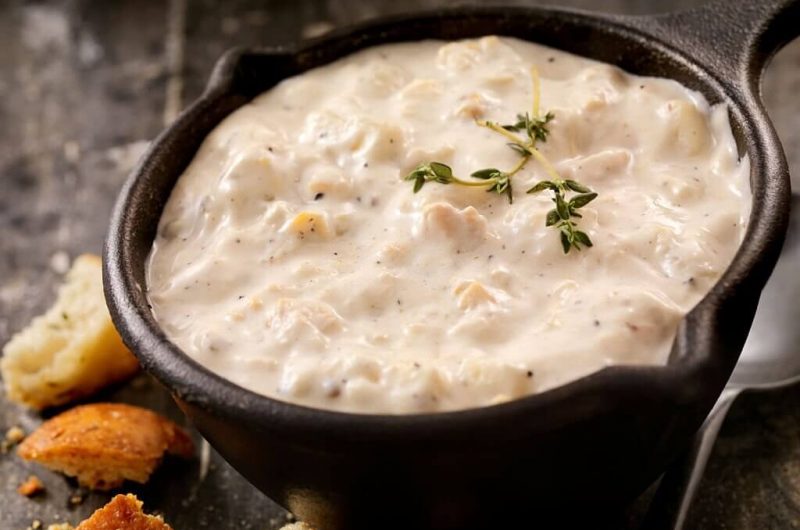Looking for the best potatoes for clam chowder can be more stressful than making clam chowder, especially if you are not a potato guru. At least, if you knew a thing or two about potatoes, you could easily recognize the best potatoes to use for clam chowder.
We understand that there’s so much to choose from and very little information on which to choose from.
We are here to save you from endlessly scrolling through many review pages to end up with contradicting information.
Here’s our easy-to-understand short read that makes choosing the best potatoes for your clam chowder easier.
The Best Potatoes for Clam Chowder
Potatoes, the main ingredient in clam chowder, are often used as a thickener for clam chowder. Potatoes give clam chowder the needed thickness and premium consistency familiar to clam chowder. They are the excellent organic thickener your clam chowder cannot do without.
If you are making a bowl of clam chowder for your next meal, here is a short list of the best potatoes for clam chowder:
Russet Potatoes

Also known as Idaho potatoes, russet potatoes are one of the most popular potatoes. Russet potatoes have a mild flavor and fluffy texture, making them a common choice for mashed and baked potatoes, and when fried, they make the crispiest French fries.
Russet potatoes are our top recommended for clam chowder because they have an arid flesh. The dry flesh helps russet potatoes do a better job at thickening than other potatoes because they contain less water.
Russet potatoes are usually in season from mid-August until the end of September. Nevertheless, you can find russet potatoes anytime at your local grocery store or online stores like Instacart.
Pros:
- Texture: Russet potatoes break down easily during cooking, which helps to thicken the broth of the clam chowder. They also have a soft, fluffy texture that adds to the overall creaminess of the chowder.
- Flavor: Russet potatoes have a mild, slightly earthy flavor that complements the other ingredients in the chowder. They do not overpower the flavor of the clams or other seasonings.
- Availability: Russet potatoes are widely available at most grocery stores and are relatively inexpensive compared to other potato varieties.
Cons:
- Appearance: The rough, brown skin of russet potatoes can be unappealing in a finished dish, particularly if the skin is not peeled before cooking. This can be mitigated by peeling the potatoes or using a potato variety with a smoother skin.
- Starch content: Russet potatoes have a high starch content, which can cause them to break down too much and turn the chowder into a thick, gluey mess. To prevent this, it’s important to cook the potatoes just until they are tender and not overcook them.
Best uses in clam chowder:
Russet potatoes are best used in creamy clam chowder recipes that require a thick, velvety broth. They are particularly well-suited to New England-style clam chowder, which relies on a thick broth made from cream and potatoes. When using russet potatoes in clam chowder, it’s important to dice them into small, uniform pieces to ensure even cooking and to prevent them from breaking down too much.
Red Potatoes

Red potatoes get their name from their thin red skin. They are also known for their slightly oblong or, sometimes, rounded shape.
Red potatoes’ mildly sweet flavor and creamy texture place them second on our list of best potatoes for clam chowder.
Red potatoes can be baked or mashed, but often they are used to add a vibrant red tone to side dishes like salads, stews, and soups.
Red potatoes are often in season around late summer through early fall.
If you are a potato guru, our third-best potato for clam chowder might not shock you.
Pros:
- Flavor: Yukon Gold potatoes have a distinct buttery, nutty flavor that adds depth and richness to the chowder. They also have a slightly sweet taste that complements the briny flavor of the clams.
- Texture: Yukon Gold potatoes have a waxy texture that holds up well during cooking, which makes them a good choice for clam chowder recipes that require diced potatoes. They also have a creamy texture that contributes to the overall silkiness of the chowder.
- Appearance: Yukon Gold potatoes have a smooth, golden skin that looks attractive in the finished dish. They can be left unpeeled for added texture and visual appeal.
Cons:
- Availability: Yukon Gold potatoes may not be as widely available as other potato varieties and may be more expensive.
- Starch content: Yukon Gold potatoes have a medium starch content, which means they may not thicken the broth as much as other potato varieties. However, they still contribute to the overall creaminess of the chowder.
Best uses in clam chowder:
Yukon Gold potatoes are best used in creamy clam chowder recipes that require a velvety broth with chunks of potato. They work particularly well in Manhattan-style clam chowder, which features a tomato-based broth. When using Yukon Gold potatoes in clam chowder, it’s important to dice them into small, uniform pieces to ensure even cooking.
Yukon Gold

Yukon Gold potatoes are easily one of the widely known and best-selling potatoes in the US market today.
Yukon Gold potatoes have a natural buttery flavor, making them one of the best potatoes for clam chowder. With its fluffy texture, Yukon Gold is the ideal potato for just about any dish that calls for potatoes. They can be baked, sautéed, roasted, mashed, or boiled.
Yukon Gold potatoes are mainly in season during summer and fall but are often available for purchase all year round, and you’ll often find them where you buy fresh vegetables or at a grocery store.
Pros:
- Flavor: Red potatoes have a mild, slightly sweet flavor that complements the briny taste of the clams. They also have a slightly nutty flavor that adds depth to the chowder.
- Texture: Red potatoes have a waxy texture that holds up well during cooking, which makes them a good choice for clam chowder recipes that require diced potatoes. They also retain their shape well and do not break down as easily as other potato varieties.
- Appearance: Red potatoes have a thin, red skin that looks attractive in the finished dish. They can be left unpeeled for added texture and visual appeal.
Cons:
- Starch content: Red potatoes have a low starch content, which means they may not thicken the broth as much as other potato varieties. However, they still contribute to the overall creaminess of the chowder.
- Availability: Red potatoes may not be as widely available as other potato varieties and may be more expensive.
Best uses in clam chowder:
Red potatoes are best used in chunky clam chowder recipes that require diced potatoes. They work particularly well in Manhattan-style clam chowder, which features a tomato-based broth. When using red potatoes in clam chowder, it’s important to dice them into small, uniform pieces to ensure even cooking.
Yellow Finn Potatoes

Yellow Finn potatoes are often described as having dark yellow and pasty flesh with a flat oval or pear shape and deep yellow skin.
Yellow Finn potatoes are sweeter than Yukon Gold and are followed with a rich, creamy, buttery flavor that adds a slightly sweet, creamy feel to clam chowder. Yellow Finn potatoes can be fried, boiled, mashed, or baked and can be used in potato salads.
Yellow Finn potatoes are generally available from mid-August until mid-April.
Read also: Yellow Potatoes Vs Yukon Gold – Top Differences
When shopping for potatoes physically, follow these tips:
- Weigh the potatoes with your hands and only choose heavier ones
- Avoid potatoes with many holes; only choose potatoes with smooth and blemish-free skin
- Avoid potatoes that look shriveled or that have wrinkles
- If the potatoes have a rotten odor, avoid them, as they may have gone bad
- Avoid potatoes that have developed a green color; they may have toxins or a bitter taste
- Dark spots and blemishes on potatoes may indicate spoilage
- Mold growth on potatoes might also be an indicator that the potatoes are bad
- If you notice that their exteriors are soft rather than firm, don’t buy them; they are likely spoilt
Read also: Do Potatoes Have Genders?
Other potato varieties
While russet, Yukon Gold, and red potatoes are some of the most popular potato varieties used in clam chowder, there are many other potato varieties that can be used in this dish. Here are some other potato varieties that can work well in clam chowder, along with their pros and cons.
- Fingerling potatoes: Fingerling potatoes are small, thin potatoes with a knobby shape and a waxy texture. They come in a variety of colors, including yellow, purple, and red. Pros of using fingerling potatoes in clam chowder include their unique appearance and their firm, creamy texture. However, they may be more expensive than other potato varieties and can be difficult to find.
- Baby potatoes: Baby potatoes are small, round potatoes with a thin, tender skin and a waxy texture. They come in a variety of colors, including yellow, red, and purple. Pros of using baby potatoes in clam chowder include their small size, which makes them easy to dice, and their creamy texture. However, they may be more expensive than other potato varieties and may require more time to dice due to their small size.
- Purple potatoes: Purple potatoes have a dark, purplish skin and a white or yellow interior. They have a slightly sweet, nutty flavor and a waxy texture. Pros of using purple potatoes in clam chowder include their unique color and their creamy texture. However, they may be more expensive than other potato varieties and can be difficult to find.
- Waxy potatoes: Waxy potatoes, such as new potatoes or fingerling potatoes, have a firm, waxy texture that holds up well during cooking. They are a good choice for clam chowder recipes that require diced potatoes. However, they may not thicken the broth as much as other potato varieties and may be more expensive than other options.
When choosing a potato variety for clam chowder, it’s important to consider its texture, flavor, and starch content. By experimenting with different potato varieties, you can find the perfect potato to suit your personal taste and cooking preferences.
Our Best Clam Chowder Recipe
This clam chowder recipe is especially delicious in a way that makes you want more, even when you are full. The highlight of this recipe for us is the douse of wine that gives the dish a bright floral note.
8
servings20
minutes40
minutes201
kcalThe highlight of this recipe for us is the douse of wine that gives the dish a bright floral note.
Ingredients
24 quahog clams (rinsed)
¼ pound of diced slab bacon or salt pork
3 big Yukon Gold potatoes, cubed
3 sprigs of thyme
½ cup of dry white wine
1 tablespoon of unsalted butter
1 bay leaf
2 cups of cream
¼ cup of chopped parsley
2 leeks (tops removed, halved, and cleaned, then sliced into half-moon)
Freshly ground black pepper
Directions
- Place the clams in a large oven, pour four cups of water, and place over medium to high heat. Cover the clams and cook until the clams open (approximately 10 to 15 minutes). Do away with clams that refuse to open after 20 minutes.
- Drain the clam broth with a sieve lined with cheesecloth and set it aside. Take out the clams from the shells and put them aside too.
- Rinse the pot and place it back on the stove. Introduce butter to the pot, and set the heat to medium-low. Next, follow with the slab bacon or salt pork. Allow it to cook while stirring periodically until the fat has melted and the pork begins to brown. Use a slotted spoon to separate the pork from the fat, and set both aside.
- Stir the leeks into the fat, and allow them to cook while stirring repeatedly. Do this until they are tender.
- Stir in the potatoes and wine, and continue cooking. Do this until the wine has completely evaporated and the potatoes become soft. Next, pour the clam broth (add enough to cover the potatoes). Follow with the thyme and bay leaf.
- Cover the pot but not completely, and allow to simmer until the potatoes soften.
- Chop the clams into the size of the diced bacon.
- When the potatoes are softened, pour the cream and stir in the chopped clams and leftover bacon. Add black pepper. Allow this to simmer, and remove it from the heat. Take out the thyme and the bay leaf, and trash them.
- The chowder should sit for a while to get a rounded flavor. Before serving, repeat it to a simmer. Add chopped parsley for your garnish and serve with oyster crackers or your preferred side dish (see above).
Recipe Video
What is Chowder?
Chowder is a soup or stew made with vegetables or seafood. Chowder often contains cream, onions, tomatoes, and potatoes and has a thick and chunky texture.
England and France are often credited as the originators of this delicious dish. It is often said that French and English immigrants brought chowder to North America over three centuries ago.
Now, chowder is recognized widely around the US as a delicious and easy-to-prepare dish. Some popular variations of chowder include seafood chowder, clam chowder, and Irish fish chowder.
Are Russet Potatoes Good for Chowder?
Russet potatoes are one of the best for clam chowder because they have dry flesh that lets them absorb water better and thicken chowder excellently.
Russet potatoes have a waxy and fluffy feel that adds positively to the texture profile of chowder; they don’t break down or disintegrate when cooked in chowder.
Russet potatoes’ mild flavor allows them to take in chowder flavors without being overpowering.
Read also: How to cook frozen diced potatoes in the oven – Useful cooking tips
What Goes Well with Clam Chowder?
Clam chowder is a versatile dish that can be paired with many foods, from spicy to creamy and savory.
Here’s our list of 20 dishes that go well with clam chowder:
- Ceasar salad
- Oven-fried zucchini
- Sourdough bread
- Jalapeno cheddar skillet cornbread
- cheese sandwich
- Grilled cheese
- Avocado and lime shrimp salad
- Citrus peanut slaw
- Avocado and corn salad
- Oyster crackers
- Cornbread
- Smoked salmon bagel
- Clam chowder potato cakes
- Sesame cucumber salad
- Cornmeal pancakes
- Biscuit muffins
- Vegan apple arugula salad
- Baked cheese quesadillas
- French fries
- Bacon and parmesan pasta salad
How Do I Make Potato Chowder?
As easy as it is to make chowder, things can go wrong fast, and we don’t want that for you. Here’s our step-by-step potato chowder recipe to make things easier:
- Prep time: 20 minutes
- Cooking time: 30 minutes
- Total time: 50 minutes
- Servings: 8 servings
Ingredients
- 2 cups of potatoes (peeled and diced)
- ½ cup of diced carrots
- ¼ cup of butter
- ½ cup of celery (diced)
- ¼ cup of onion (chopped)
- 2 (15-ounce) cans of whole kernel corn, drained
- ¼ cup of all-purpose flour
- 1 teaspoon of salt
- 2 cups of milk
Preparation
- Add potatoes, carrots, onions, celery, and salt in a large pot. Add some water (ensure it covers the ingredients) and boil. Afterward, reduce the heat and allow them to simmer for about 20 minutes.
- Mix butter, milk, and flour in a saucepan over medium heat. Stir the mix until it is smooth and thick.
- Add the mixture to the pot of boiled vegetables in step 1. Follow with corn and cheese, and stir until the cheese is completely melted. Serve and enjoy!
Frequently Asked Questions (FAQs)
Under medium to low heat, it can take up to 20 minutes for potatoes to cook in chowder.
It takes anything from 30 minutes to 3 hours to cook chowder completely.
Chowder cooking time largely depends on the recipe and ingredients you are using. However, a standard recipe often gives you an almost accurate cooking time, so you know how long you will make the dish.
Potato chowder can last for up to two hours at room temperature.
If the potato chowder is kept in an airtight container in the fridge, it can stay for up to 3 or 4 days before it begins to spoil.
In the freezer, potato chowder in an airtight container can be safely stored for up to 4 or 6 months before losing its quality.
While chowder and soup are both types of liquid-based dishes, there are some key differences between the two.
One of the main differences is the consistency. Chowder is typically thicker and creamier than soup, due to the use of milk, cream, or a roux (a mixture of flour and butter) as a thickening agent. This gives chowder a more substantial, almost stew-like quality, whereas soup tends to be thinner and more brothy.
Another difference is the ingredients. Chowder is typically made with chunks of seafood, potatoes, and other vegetables, while soup can be made with a wider variety of ingredients, including meat, beans, grains, and vegetables.
Finally, chowder often has a specific regional association, such as New England clam chowder or Manhattan clam chowder, whereas soup can be found in a variety of forms and flavors across many different cultures and cuisines.
Chowder is not an Italian or French dish. Chowder is actually a type of seafood stew that originated in North America, specifically in the coastal regions of New England and Atlantic Canada. The exact origins of chowder are uncertain, but it is believed to have been influenced by the cooking traditions of early European settlers, particularly those from England and France.
Over time, chowder became a popular dish in many parts of North America, with different variations emerging based on the availability of local ingredients. For example, New England clam chowder is made with clams, potatoes, onions, and milk or cream, while Manhattan clam chowder is made with clams, tomatoes, and a vegetable broth.
While French and Italian cuisines are known for their rich stews and soups, they do not have a specific dish called “chowder.” Instead, they have their own regional variations of soups and stews, such as bouillabaisse in France and minestrone in Italy.
Waxy potatoes are a type of potato that have a low starch content and a high moisture content. They have a firm, dense texture and hold their shape well during cooking. Some common varieties of waxy potatoes include:
– Red potatoes: Red potatoes have a thin, red skin and a white or yellow flesh. They are a popular variety for boiling, roasting, and using in salads due to their waxy texture.
– Fingerling potatoes: Fingerling potatoes are small, thin potatoes with a knobby shape and a waxy texture. They come in a variety of colors, including yellow, purple, and red.
– New potatoes: New potatoes are small, immature potatoes with a thin skin and a waxy texture. They are harvested early in the growing season and are often boiled or roasted whole.
– Yukon Gold potatoes: While Yukon Gold potatoes are not typically classified as waxy potatoes, they have a medium starch content and a waxy texture that makes them a good choice for boiling, mashing, or using in salads.
Overall, waxy potatoes are a good choice for dishes where you want the potato to hold its shape, such as potato salads, roasted potatoes, or stews.






